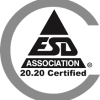ESD s20.20 | Electrostatic Discharge Control Program Standard

ELECTROSTATIC DISCHARGE (ESD)
Electrostatic discharge (ESD) and static electricity can cause numerous problems for organizations across several industries, particularly the electronics industry. Product quality and reliability, manufacturing costs and production can all be affected by ESD. In ordinary circumstances, static electricity and ESD are little more than annoyances, however, at times these shocks can be as powerful as 1000v or more. Unprotected electronic components as simple as diodes to complex hybrids can very easily be damaged and become defective by such Electrostatic charges.

The ESD Association has a new ESD Control Program standard: ANSI/ESD S20.20 certification for the Development of an Electrostatic Discharge Control Program for – Protection of Electrical and Electronic Parts, Assemblies and Equipment (Excluding Electrically Initiated Explosive Devices). ANSI/ESD S20.20, Electrostatic Discharge Control Program Standard, was created to help organizations design, develop, implement and maintain an Electrostatic Discharge (ESD) Control Program to protect ESD-sensitive electrical or electronic parts, assemblies and equipment from being damaged by Human Body Model (HBM) discharges greater than or equal to 100 volts.
Utilized by many international OEM’s and serving as the replacement for Mil-std 1686, the ESD s20.20 standard covers the requirements necessary to design, establish, implement and maintain an Electrostatic Discharge (ESD) control program. This is vital for organizations that manufacture, process, assemble, install, package, label, service, test, inspect or handle electrical or electronic parts, assemblies and equipment susceptible to damage by electrostatic discharges. Industry giants such as IBM, Lucent and Lockheed Martin have all adopted or require their subcontractors to implement S20.20. There are three fundamental control principles included in this standard:
- All conductors in the environment, including personnel, must be bonded or electrically grounded.
- Ionization systems must be used to neutralize charges on necessary nonconductors in the environment.
- ESDS items being transported outside an Electrostatic Protected Area must be enclosed in static protective materials.
- An ESD S20.20 certification by an independent party such as ISA and recognized by the Electrostatic Discharge Association is becoming an industry standard and is required by many OEMs
- ESD control program helps eliminate component failures before they occur, thus saving organizations valuable time, money and increasing customer satisfaction
- ANSI/ESD s20.20 integrates well and complements existing management systems such as ISO 9001, AS9100, AS9120, ISO 13485 and others, however, they are not prerequisites for an ANSI/ESD S20.20 program
- Improves overall process performance and preservation of products
- Provides visible proof of organization’s commitment to ESD controls during customer’s site visits
- Increases marketability
The ANSI/ESD S20.20 Electrostatic Discharge Control Program Standard is divided into two main parts: Administrative Requirements and Technical Requirements.
Administrative Requirements include:
- ESD Control Program Plan
- Training Plan Requirement
- Compliance Verification Plan
Technical Requirements include:
- Grounding / Bonding Systems
- Personnel Grounding
- Protected Areas
- Packaging
- Marking
- Equipment
- Handling
Whenever you are ready to obtain your ANSI ESD s20.20 Certification and take your business performance to the next level please contact us at (951) 736-0035. We look forward to hearing from you!
